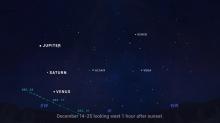Listen to today's episode of StarDate on the web the same day it airs in high-quality streaming audio without any extra ads or announcements. Choose a $8 one-month pass, or listen every day for a year for just $30.
You are here
Giant Break-Up
A giant comet may have broken up about 20,000 years ago. And we see the effects of that break-up today.
The main remnant of the object appears to be Comet Encke. It’s about three miles wide, and orbits the Sun once every 3.3 years. It’s the source of several meteor showers. It sheds grains of rock and dirt as it orbits the Sun. They spread out to form wide clouds. When Earth flies through such a cloud, it spawns a meteor shower. The best known is the Taurids, in November.
Astronomers have supposed that Encke was the remnant of a larger body for decades. But a study last year found that it has a lot of company. Researchers found 88 small comets and asteroids that appear to be related. When they traced the orbits of these bodies back in time, they found that all of them appear to meet up about 20,000 years ago.
The original body could have been up to 75 miles wide. It probably was a cosmic “rubble pile” — big chunks of rock held together by ice. That made it easier to pull apart. As it split up, it sent Encke and many other bodies off on their own.
One of those bodies might have been the asteroid that exploded above Tunguska, Russia, in 1908. It was only a couple of hundred feet wide, but it leveled several square miles of forest. And it’s possible that more bodies like that could lurk in the debris — cosmic missiles that could someday hit Earth.
We’ll talk about the remnants of another large body tomorrow.
Script by Damond Benningfield






